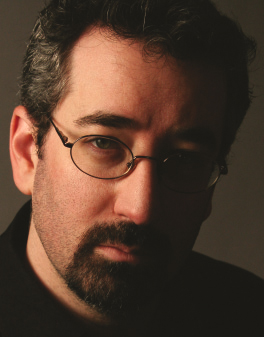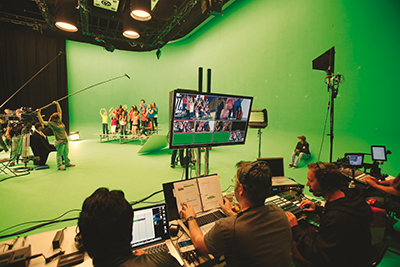Estimating Green Screen Lighting

JAY HOLBEN
I received an email question the other day about lighting a green screen and thought it might be of use for me to share my response and thoughts here.
The question seemed simple: “Can I light an 18-foot-wide-by-12-foot-high green screen with two Kino Flo Image85 units, or do I need more?”
I suppose I could have responded with a simple “Yes, you can, but I’d recommend three” and called it a day; but that answer was inadequate (and it’s very unlike me to be simple in any response!). To be thorough, I had to ask a few questions: How far away from the screen can the Kinos be and what stop (brightness) do they need from the screen?
Keeping in mind that you want to keep your talent as far away from the green as possible to avoid spill and corruption, you want the biggest green you can afford (both cost and space). If your space is limited where your talent has to be very close to the green, you’re going to have a lot of problems with spill.
A WORKHORSE

From The Event Premiere, a recent job I produced and directed on the UVS1—Universal Studio’s customized virtual stage. This screen is prelit with 29 Kino Flo Image80s and 21 6K spacelights. The Kino Image85 is a great workhorse fixture for lighting green screen. It’s very soft, broad, DMX addressable, even has Pole- Op options with a yoke that is adjustable from below with a long pole. I started with a refresher on Kino’s published photometrics for the Image85, which states that the fixture has an output of 160 footcandles at 6 feet.
The professional video industry's #1 source for news, trends and product and tech information. Sign up below.
As a general rule of thumb, your fixtures— especially with Kino’s—want to be at least half the screen height away from the screen. This will give you a pretty even field from top to bottom on your screen.
In this case, we were talking about a 12- foot high screen, so the fixtures, in an optimum setting, should be 6 feet away. However, the further away you position your fixtures, the more you can optimize even coverage, with the compromise of your exposure level.
The real question here is how wide will the coverage from the Image85s be? Unfortunately, here, the published photometrics aren’t going to help. Kino doesn’t readily say how wide their field of illumination is, but my experience tells me I can hang Image85s on a 66-inch center (gives me a foot between fixtures) to get great coverage.
The reflectors in the 85s are optimized for vertical spread, not horizontal spread, so the closer you get the fixtures together, the better you are in terms of smooth coverage across the screen from the optimum distance. But that’s not to say you can’t move them further back and spread them out a bit.
As with many things in our industry, there is a nearly infinite variety of green screen admaterial, colors and saturations. I typically estimate a 25–35 percent reflectivity off of green, which covers most typical greens from chroma to digi. Some darker, less saturated green material will have less reflectivity but 25–35 percent is a comfortable range for estimating.
PYTHAGOREAN THEOREM

Figuring out the math of throw distance utilizing Pythagorean Theorem to estimate the fixture’s output and reflected light for our exposure Now 6 feet away is a bit of a ruse because you’re going to be focusing your fixture at the center (or lower 1/3, depending on your preference) of the screen to get a good even field of illumination from top to bottom. To figure out our real throw distance, we’ve got to go to a little geometry and pull out some Pythagorean Theorem here.
If our wall is 12 feet high and we’re focusing at the middle of that wall (6 feet), and we’re positioning our fixture 6 feet away from the wall, that’s two sides of a right triangle. To figure out our hypotenuse, we’ve got to remember that A2 + B2 = C2.
Our A, in this case is 6 feet (mid-height on the green screen) and our B is 6 feet (distance away from the screen). That’s 36 + 36 = 72. The square root of 72 is 8.48. So at 6 feet away from the screen, the center focus of our Kino is 8.48 feet away.
Utilizing one of my favorite iApps—Michael Zinman’s PocketLD— I can calculate the output of an Image85 at 8.48 feet to be 84.83 fc. If my worst-case scenario is a screen with a reflectivity of 25 percent, that gives me an illumination of 63.62 footlamberts off the screen. At 200 ISO, 24 fps with a 180-degree shutter, 64 footlamberts will give me an f/3.2 (2.8 + 1/3).
Not too bad, 2/3 shy of a 4 at 200 ISO is a pretty solid exposure. If we’re figuring that at the optimum distance away, with 1 foot between fixtures, I’ve got even coverage. That means my light extends out 6 inches on either side of my fixture evenly.
So two fixtures, side-by-side at optimum distance away will give me about 10.5 feet of coverage—not enough to cover the 18- foot field. I know I’ve got room to spare with most digital systems, so I could move the Image85s a little further away from the screen than 6 feet, spread out the light a bit more, lose some stop, but help with overall spread.
If we went to 10 feet away from the screen, recalculated our Pythagorean, we’d have a throw of 11.66 feet. At that distance, our output drops to 44.87 fc or 33.65 fl (off the 25-percent reflective screen). That gives us an f/3.2 at 400 ISO—just a stop loss. Still good, not pushing the limits of most digital systems and we should be able to cover most of the 18-foot width with two fixtures.
This is all a long-winded way of saying “yes, you can probably get away with two (with compromises), but I’d highly recommend three.”
Jay Holben is the technical editor of Digital Video and a contributor to Government Video. He is also the author of the book “A Shot in the Dark: A Crative DIY Guide to Digital Video Lighting on (Almost) No Budget.”
